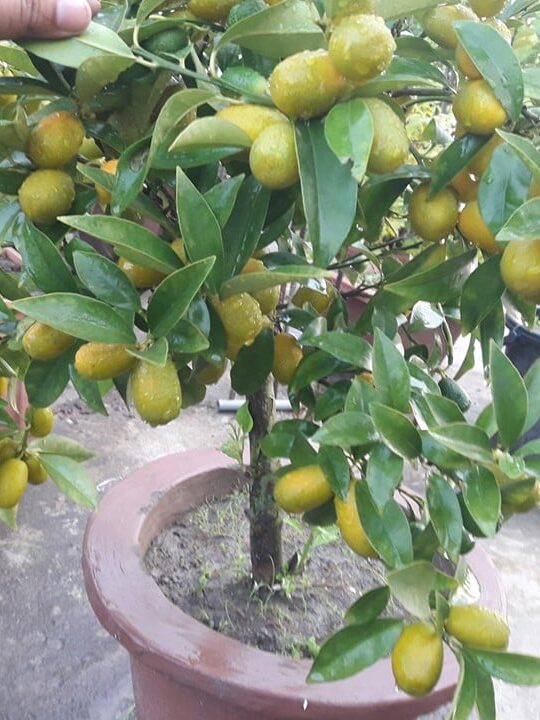Citrus Japonica, commonly known as the kumquat, is a small, citrus fruit that is native to China. The fruit is about the size of a large grape and has an edible peel, which is sweet and tangy, and a sour pulp. Kumquats are often eaten fresh, used in desserts, or made into marmalades and jams. Kumquats are also used in traditional Chinese medicine, where they are believed to have a variety of health benefits.

Kumquats were introduced to the United States in the mid-19th century. The first recorded shipment of kumquats to the United States was in 1850, when a shipment of kumquat trees was sent from China to California. The trees were originally grown as ornamental plants, but their fruit soon became popular among local residents.
Over the years, kumquats have become an important crop in California, Florida, and other citrus-growing regions of the United States. Today, the United States is one of the world’s largest producers of kumquats, with most of the crop coming from California.

Kumquats are a relatively easy fruit to grow and are resistant to many of the diseases that affect other citrus crops. They are also a popular choice for home gardeners, as they require little maintenance and produce fruit year-round.
In addition to their use in food and medicine, kumquats have also become a popular ornamental plant in the United States. The trees are often grown for their attractive foliage and fragrant flowers and are a common sight in gardens and parks throughout the country.
Growing Citrus Japonica Varieties and Their Benefits
Citrus Japonica, or Kumquat, can be grown in many parts of the United States, particularly in regions with a warm, subtropical climate. Some of the best states for growing Kumquats include Florida, California, Texas, and Louisiana.

When growing Kumquats in the United States, it’s important to choose the right variety for your region. The Nagami and Marumi are two of the most popular varieties of Kumquats grown in the US. Nagami Kumquats are oval-shaped with a tart flavor, while Marumi Kumquats are small and round with a sweeter taste.
There are many benefits to growing and consuming Citrus Japonica varieties. Kumquats are a good source of vitamin C, fiber, and antioxidants. They are also low in calories and high in water content, making them a great addition to a healthy diet.

In addition, Kumquats have been shown to have anti-inflammatory properties and may help improve digestive health. They are also a good source of potassium, which can help regulate blood pressure and support heart health
Unique Taste Profiles of Citrus Japonica Varieties
Citrus Japonica, commonly known as kumquats, are small, oval-shaped fruits that are native to Asia. They have a unique taste profile that is both sweet and sour, with a slightly bitter aftertaste. However, the taste profile can vary between the different varieties of kumquats.
One popular variety is the Nagami kumquat, which is the most commonly grown kumquat in the United States. It has an oblong shape and a bright orange color when ripe. The Nagami kumquat has a sweet and tart flavor, with a slightly bitter aftertaste. The skin is also edible and has a slightly bitter taste.
Another variety is the Marumi kumquat, which is smaller and rounder than the Nagami kumquat. It has a sweeter taste than the Nagami kumquat, with a less pronounced sourness. The skin of the Marumi kumquat is also sweeter than the Nagami kumquat.

The Hong Kong kumquat is another variety that is known for its unique taste profile. It has a sweet and tangy flavor, with a hint of bitterness. The skin is also edible and has a sweet and slightly bitter taste.
Uses for Citrus Japonica Fruits & Zests
Citrus Japonica fruits, commonly known as kumquats, and their zests are versatile ingredients that can be used in a variety of dishes and recipes. Here are some popular uses for kumquats and their zests:
- Candied kumquats – Kumquats can be candied by boiling them in sugar syrup, which creates a sweet and tangy treat. Candied kumquats can be enjoyed on their own or used as a topping for desserts.
- Marmalade – Kumquat marmalade is a popular preserve made by cooking kumquats with sugar and water until they break down into a spreadable consistency.
- Cocktails – Kumquat juice, zest, and slices can be used in a variety of cocktails, such as kumquat margaritas, kumquat martinis, and kumquat mojitos.
- Salad dressing – Kumquat juice and zest can be used to make a tangy salad dressing that pairs well with bitter greens like arugula.
- Marinades and sauces – Kumquat juice and zest can be used in marinades and sauces for chicken, fish, and pork to add a sweet and tangy flavor.
- Baked goods – Kumquat zest can be used in baked goods like muffins, cakes, and cookies to add a citrusy flavor.
- Garnish – Kumquat slices and zest can be used as a garnish for dishes like roasted meats or fish to add a pop of color and flavor.
Kumquats and their zests are versatile ingredients that can be used in sweet and savory dishes, as well as in cocktails and other beverages. Their unique sweet and sour flavor adds a delicious twist to any recipe.

